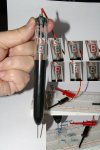westaust55
Moderator
In a previous life long ago, I had a home brew 5 state TTL logic probe for 5V supplied circuits but since resumption with electronics projects and PICAXE microcontrollers 3 years ago, test tools have been only a DMM, not that I have had any problems needing oscilloscopes, etc thus far.
That said, I decided to create a new Logic Probe based on a 14M PICAXE chip.
Many simpler logic probes use two or three LEDs as the logic state display and a few use a 7-segment display to show “H” or “L”.
Considering that PICAXE chips are now available in lower voltages my logic probe has considered a nominal range of 3 Volts to 4.5 Volts and 5 Volts as the circuit supply voltage. Accordingly a simple form of automatic supply voltage level detection is included. The circuit voltage level detection uses the forward volt drop across a 1N914 diode as a rough voltage reference.
The logic probe can indicate 9 separate “states” or voltage levels as:
While most of the time a “1” or “0” will be displayed, noting that occasional folks have had problems with for example, a lower voltage TTL acceptable level “high” signal onto a Schmitt Trigger (ST) input not working, having the differentiation for ST and CMOS may be warranted in some cases.
The circuit as posted is working well on a breadboard and I now about to assemble on a PCB and install into a 2cm diameter pen housing.
The 14M output 0 was deliberate not used to drive the 7-segment display and thus is available to allow interface to a terminal window should one wish to pass any status data on to a terminal screen. By way of example I pass the supply voltage as detected and with around 20 program bytes remaining a couple of extra variables could also be transferred if desired.
For those who are interested, the program listing is attached and embedded within the comments is a pseudo schematic with PICAXE 14M pin assignments.
Note for clarity the resistors for the programming circuit are omitted.
That said, I decided to create a new Logic Probe based on a 14M PICAXE chip.
Many simpler logic probes use two or three LEDs as the logic state display and a few use a 7-segment display to show “H” or “L”.
Considering that PICAXE chips are now available in lower voltages my logic probe has considered a nominal range of 3 Volts to 4.5 Volts and 5 Volts as the circuit supply voltage. Accordingly a simple form of automatic supply voltage level detection is included. The circuit voltage level detection uses the forward volt drop across a 1N914 diode as a rough voltage reference.
The logic probe can indicate 9 separate “states” or voltage levels as:
Code:
0) <= ~ 0.10 V then effectively at 0V rail
1) <= ~ 0.15*Vdd and Vdd = 3 V then a TTL low state, or
if <= 0.8V at 4.5/5V then TTL low state (plus ST plus CMOS)
2) <= ~ 0.20*Vdd then a Schmitt Trigger low state plus CMOS low state
3) <= ~ 0.266*Vdd then only a CMOS low state
4) > state (3) and < state (5) is logic indeterminate or tri-stated/high impedance
5) > ~ 0.25*Vdd+0.8V and Vdd = 3 V then TTL high state or
if > 2.0 V at 4.5/5V then TTL high State
6) > ~ 0.733*Vdd then also a CMOS high state (CMOS + TTL)
7) > ~ 0.8*Vdd then also a Schmitt Trigger High plus TTL high plus CMOS high
8) > Vdd - 0.2V then effectively at Vdd railThe circuit as posted is working well on a breadboard and I now about to assemble on a PCB and install into a 2cm diameter pen housing.
The 14M output 0 was deliberate not used to drive the 7-segment display and thus is available to allow interface to a terminal window should one wish to pass any status data on to a terminal screen. By way of example I pass the supply voltage as detected and with around 20 program bytes remaining a couple of extra variables could also be transferred if desired.
For those who are interested, the program listing is attached and embedded within the comments is a pseudo schematic with PICAXE 14M pin assignments.
Note for clarity the resistors for the programming circuit are omitted.
Attachments
-
10.9 KB Views: 194
-
5.5 KB Views: 129
Last edited:





